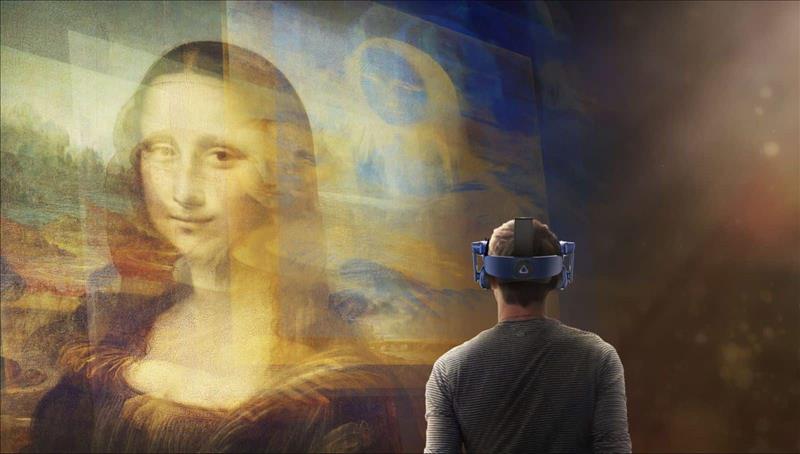
Virtual Reality Experiences In American Art Museums
The world of art and the advancements of technology have long had a symbiotic relationship, but never more so than today. As museums across the United States embrace the possibilities of virtual reality (VR), the experiences they offer are reshaping the way we interact with art. From immersive installations to guided tours through historical contexts, VR is redefining the boundaries of cultural experiences within the walls of American art museums. In this article, we will explore the transformative power of virtual reality art, examine notable VR museums, and outline curated USA art experiences that leverage this technology.
Still from Mona Lisa Beyond the Glass. Courtesy of Emissive and HTC Vive Arts. The Dawn of Virtual Reality Art
Virtual reality art is not merely about creating a new medium; it reflects a paradigm shift in how we conceive and engage with artistic expression. By using VR headsets and interactive platforms, artists can create and manipulate digital environments that transport viewers into alternate realms of consciousness. This medium allows audiences to experience art in dynamic and multisensory ways, transcending the traditional limitations of paintings hung on walls or sculptures set on pedestals.
In many ways, VR is the closest we can get to stepping inside a piece of art. Imagine wandering through Van Gogh's 'Starry Night,' enveloped in a swirling cosmos of color and motion. Imagine standing among the sculptures of Rodin, navigating around them as if they were alive, breathing entities. Such experiences are what VR offers the discerning art enthusiast, allowing them not only to observe but to participate in the artistic narrative.

Still from Mona Lisa Beyond the Glass. Courtesy of Emissive and HTC Vive Arts. The Integration of VR in American Art Museums
American art museums have been quick to adapt these transformative technologies. The integration of virtual reality experiences is seen as a response to the burgeoning demand for innovative ways to engage with art. Museums like the Smithsonian American Art Museum, the Los Angeles County Museum of Art (LACMA), and the Museum of Modern Art (MoMA) have pioneered various initiatives embedding VR in their programming.
Smithsonian American Art Museum: Immersing in America's Artistic Heritage
The Smithsonian American Art Museum has leveraged virtual reality to enhance its educational programming. One standout initiative is the“Virtual Reality Tour of American Art,” which allows visitors to explore key pieces of American art through immersive storytelling. This experience is designed to provide context, revealing the history and culture surrounding creations that have defined the American identity. Visitors can find themselves in vivid reconstructions of historical moments that shaped the subjects of various paintings and sculptures, offering profound insights into the lives of both the artists and the artwork.
Los Angeles County Museum of Art (LACMA): A Journey Through Time and Space
At LACMA, virtual reality technology has taken museum visitors on an exciting journey. One particularly notable project is“The L.A. Painting Project,” showcasing the evolution of California's art scene. Using VR, guests can step into different decades and experience panoramic views of exhibitions featuring influential artists, their works, and the socio-political climate of their time. This experience is both visually exhilarating and intellectually stimulating, allowing users to understand the interconnectedness of art within historical contexts.
Museum of Modern Art (MoMA): Art Meets Technology
The Museum of Modern Art in New York has also engaged with virtual reality, notably through experiences that highlight the intersections of art and technology. Their VR installations often engage with themes of modernity, prompting visitors to reconsider what defines contemporary art within a digital landscape. Exhibits have included a VR experience that dives into the world of abstract expressionism, promoting interaction that invites emotional reactions to brush strokes and colors previously confined to a two-dimensional plane.
Curated USA Art Experiences Through VRWhile major institutions are taking lead on integrating VR, numerous smaller and localized museums are also carving out their niche in the art experience landscape. These curated experiences are not only refreshing but also highly innovative.
Virtual Tours of Local Museums
Art institutions across regions are employing VR to curate virtual tours that engage local communities. For example, the Georgia Museum of Art, through its“Museum at Home” initiative, offers curated virtual reality tours, making art accessible regardless of location. This initiative allows individuals to navigate through their galleries from the comfort of home, capturing the scene in vivid detail while simultaneously allowing viewers to listen to curators and artists discuss their work.
Collaborative Experiences with Artists
Several museums are partnering with contemporary artists to produce VR pieces that reflect their vision. The Contemporary Art Museum of St. Louis, for instance, represents a growing trend of using VR not only for showcasing static art but also encouraging artists to create original VR content. These unique projects promote collaborations that blend digital technology with artistic expression, resulting in innovative pieces that might not have been conceived outside the virtual space.
The Future of Virtual Reality in Art MuseumsAs we step further into the age of technology, the role of virtual reality art in American museums continues to expand, inviting diverse audiences to engage with creativity in novel and engaging formats. With VR, the walls of cultural institutions do not confine visitors; rather, opportunities for exploration and learning multiply.
The combination of art with immersive technologies is not merely a visualization of art; it's an evolution of how societies experience culture. The future beholds a fascinating tapestry where art museums across the USA continue to explore, innovate, and engage through virtual reality, ensuring that art remains a dialogue between creators and spectators in an ever-expanding digital realm. As museums continue to pioneer ways to embrace technology, one thing is clear: virtual reality art is just the beginning, paving the way for boundless artistic exploration in American culture for generations to come.

Legal Disclaimer:
MENAFN provides the
information “as is” without warranty of any kind. We do not accept
any responsibility or liability for the accuracy, content, images,
videos, licenses, completeness, legality, or reliability of the information
contained in this article. If you have any complaints or copyright
issues related to this article, kindly contact the provider above.
















Comments
No comment